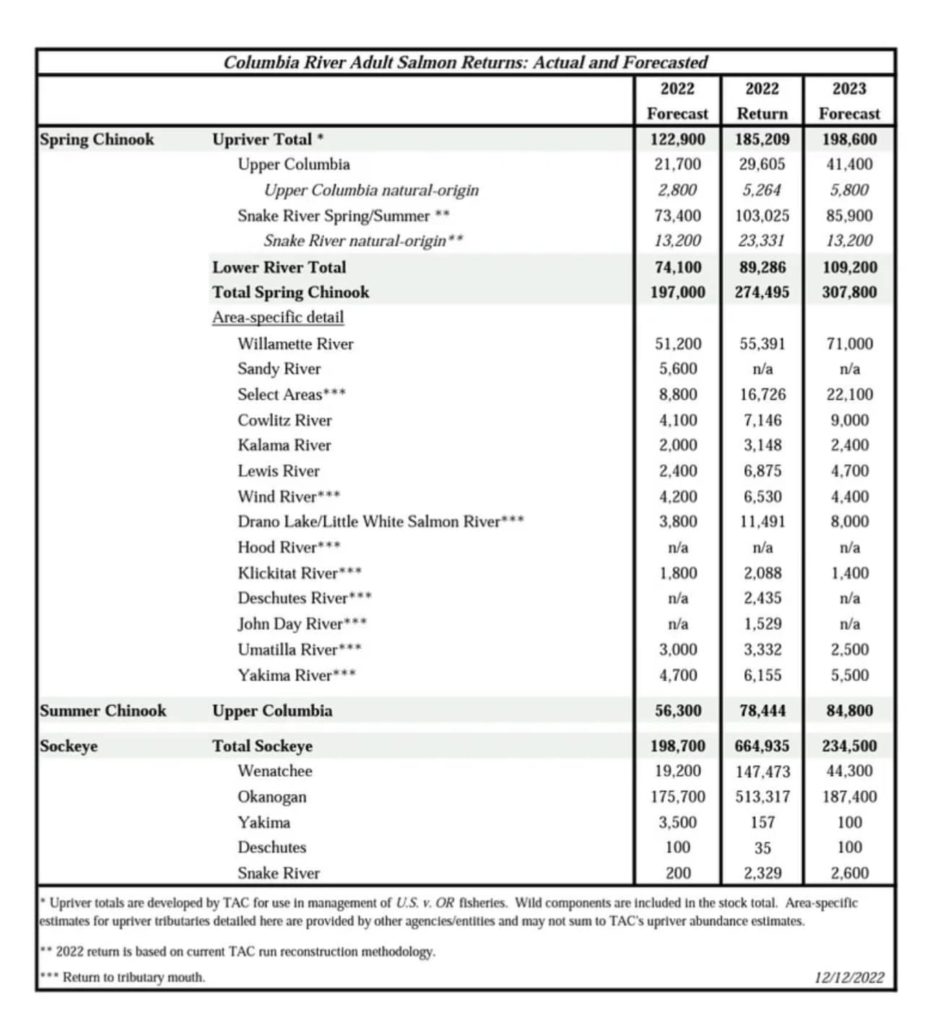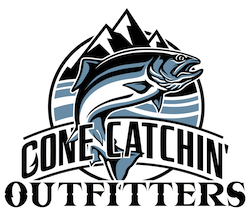2023 Columbia River Spring and Summer Forecasts Revealed | What does it all mean?

The Columbia River forecasts for Spring and Summer were just released by the Fish and Wildlife and there are some great things to come in the next year. As with any forecasts, they are just that… a forecast. However, with the way the seasons are set and managed, it’s always nice to start with a good number that the managers can get some confidence in when it comes to regulating our fishing days. As with anything you read on the internet pertaining to seasons, always check for updates, emergency regulations, and gear restrictions BEFORE you head out on the water. Things change fast in the Northwest and you are always responsible for your actions when fishing.
I’ve included the forecasts in the picture of this article for reference as I won’t go through every line item but the highlights and what to look out for when making plans for 2023.
Spring Chinook
Starting right at the top there is an upriver total forecast, in 2022 we were forecasted to 122,900 salmon. With that forecast we saw a fishery in the Lower Columbia run till April 6th and pretty much used all the impacts to the fish as were expected. Although the actual return came out much higher, at 185,200, that forecasted number has to be used to set the lower seasons as the fish will be by the dams and into the tributaries before we realize our true run size. Since everything has to be set and fished before we see actual numbers, having a run that is almost 80k larger than last seasons will mean a couple of things.
First, we will see a slightly longer season in the Lower Columbia. With such an increase in fish, you actually won’t see a crazy amount of days added to the end of the early season. Hopes of fishing till April 25th need to be dashed as catch rates increase exponentially as we get into the first days of April and even a 200k run of upriver springers couldn’t handle that. They are easy to catch and when conditions are right, we can rack up well over a thousand fish caught per day. In 2022, we had somewhere around 4,000 fish available, this year we could be around 10,000. Even with the increase for 2023, that could really only mean about half dozen additional days.
Second, we have a good chance of seeing some phenomenal fishing in May. Generally speaking, the seasons are constructed with a “buffer” in case the run comes under forecast. This protects the fish by leaving some on the table in case the run comes in short when they are hard counted at Bonneville Dam or if the early sport fishery catches too many. If it appears the run is going to be around forecast, there will still be a chunk of fish left over to catch and at that time, the Lower Columbia could see an opener. If the run comes in over forecast like it did in 2022, there could be a much larger number available providing longer and better opportunity for anglers in May.
There’s some real positive numbers in the Upper Columbia Natural Origin totals as well. Even though we are only allowed to keep hatchery fish in the Columbia for spring and our seasons are based on how many we catch, the number really is based on how many of these natural origin fish are killed by catch and release mortalities. The department figures we are only allowed to kill “X” amount of wilds, so therefor we are only allowed to catch “X” amount of wilds, and those wilds are represented by how many hatchery fish are brought back to the dock. The exact ratio of hatchery vs wild is dependent on hatchery smolt releases in the previous years and test fisheries conducted by nets in the lower river so it’s always a moving target.
When it comes to tributaries of the Columbia, there’s some even more exciting news. Starting with the Willamette forecasted to be about 20k over last years forecast of 51k. Most years, our super early fish, (February through Mid-March) primarily are Willamette bound fish. If we see increases in there, odds are we will be seeing more early fish due to the “sand pile” effect. A larger runs tends to show earlier and linger longer. Not to mention increases in Lower Columbia Tributary fish will “wash out” the total of upriver wild fish we are impacting (catching), thus allowing longer seasons. When the Columbia shuts down, there will be plenty of opportunity in the Willamette for months to come.
Other notables include the Cowlitz, with it’s 2023 forecast of 9,000 fish, that should be enough to keep the Lower Columbia open. In some years, with a depressed Cowlitz run, we’ve seen closures downstream in the Columbia to ensure as many fish get to the Cowlitz hatcheries as they can. The Kalama, Wind, and Drano all see increases to last year’s forecasts and should provide good seasons. Bag limits can vary as some hatcheries need more fish than others to propagate runs.
Sockeye
The Sockeye forecast for 2022 came in at 198,700. In order for the Lower Columbia to see a season, they must have a run size forecasted to be over 200,000. Therefor, last year there was no harvest allowed in the Lower Columbia. This has been a huge sticking point as some very knowledable anglers called foul last year on the forecast and months before the run claimed the state was under forecasting. Forecasts from up north in Alaska called for huge Sockeye runs, record setting in some instances as it was becoming apparent the sockeye were doing well in the improving ocean conditions. In 2022, the Columbia saw a record setting run of 664,935 sockeye but due to an inaccurate forecast, the Lower Columbia didn’t see a fishery until the run was mostly past. This really showcases the importance of a good forecast when it comes to season setting and what it can mean for fisheries down the road.
With 2023’s forecast of sockeye at 234,500, this should allow for a Lower Columbia fishery. With impact rates for the run in the Lower Columbia not to exceed 1%, this should leave a couple thousand fish available for harvest until we see an updated run when fish are actually counted when they cross the dam.
Summer Chinook
Now for the grand finale….. Summer Chinook last year was forecasted to be 56k and came in at a astounding 78,444. Anything over around 50k and we will see a robust Lower Columbia fishery. In 2023, that forecasted number is 84,800! I believe this is either the highest or second highest forecast in recent times for Summer Chinook and should provide some quality fishing Mid June and into July. This season can be a bit tricky as the dam counts reflect spring and summer chinook in mid June, but with the use of pit tags, the numbers get grouped into more accurate buckets for counting each run since they like to overlap. With a large run forecasted of summer chinook, you’ll see passage spike the 3rd week of June over Bonneville but with that “sand pile” effect, you can see great fishing right up to August if the seasons allow.
What’s next?
Forecasts are just the first glimpse of what we will see for seasons going into 2023. There will be many meetings, discussions, and opportunities for the public to listen in and participate in the coming months. Things change and happen fast, so my ramblings at this moment might not mean a thing when it comes to decisions made for fishing seasons but hopefully this will give you a good idea and some insight on what is hopefully to come. And of course, I will be taking as many of you as I can on some quality fishing trips this season so book as early as you can, this year will be one to remember.
Cameron

Cameron,
Great article. I am not sure where you find the time to write these articles, but I sure am glad that you do. I am looking forward to seeing you at the Sportsmans shows. Thank you for writing this.
Jim Bradbury
Cameron
Thanks for putting out this article, it’s extremely insightful and gives me ( a passive recreational angler) optimism to get my 18’ sled amongst the fleet.
I have a lot of respect for you ( we’ve chatted a few times at Merwin and sportsman’s shows) and would love your input on the recent survey the ODFW has put out.
Keep up the good work!
Thanks for the article makes me want to get the boat cleaned up from crabbing